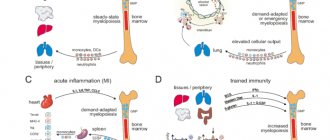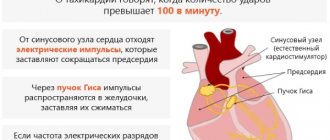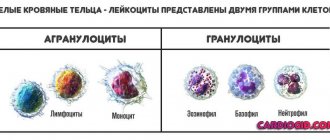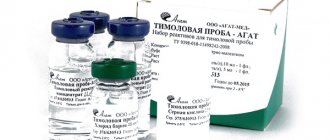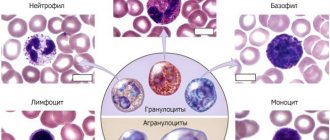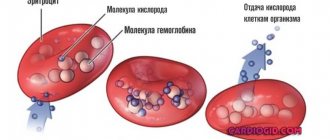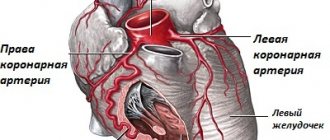There are different types of cells in the blood. One of them are monocytes. These are large cells that literally absorb bacteria, damaged structures of their own body and destroy them. An increase in the level of monocytes is a normal reaction of the body during an infectious disease or inflammatory process. But often an excess of monocytes can also indicate pathology. To reliably establish the cause, it is necessary to carry out appropriate diagnostics.
general information
Monocytes are cells belonging to the group of white blood cells. In healthy people, they make up about 3–8% of all white blood cells and are the largest blood cells found in the human bloodstream. Monocytes circulating in the blood have the ability to move from blood vessels to tissues, where they turn into macrophages, that is, phagocytic cells. Their main task is to fight bacteria and other microorganisms present in the body and produce substances that regulate the immune system.
A test that measures the number of monocytes in the blood is called a complete blood count with smear. If the result of this test shows an increased number of monocytes in your blood, you should consult your doctor as soon as possible, because such abnormalities can be caused not only by infections, but also by inflammatory, autoimmune or cancerous diseases.
blood test for monocytes in a child
Monocytosis in children
An increase in monocytes in childhood is also often associated with infectious pathologies, mainly of a viral nature. If monocytosis is diagnosed based on a blood test, this means that the body is actively fighting disease-causing processes.
Also, a similar condition is observed with helminthic lesions - enterobiasis, ascariasis and others. After the destruction of helminths, the content of monocytes returns to normal. The cause may also be associated with tuberculosis, but such pathologies are rare. Monocytosis can be observed due to oncological processes. The most common are leukemia and lymphogranulomatosis.
Other common reasons:
- poisoning;
- allergic reactions;
- inflammation in the gastrointestinal tract;
- autoimmune pathologies;
- rheumatoid type arthritis;
- Crohn's disease;
- infections due to surgical interventions.
Monocytes - what are they and what are their functions?
Monocytes, also referred to as MONO in blood counting, are one type of non-granular leukocytes, that is, agranulocytes. Monocytes are produced in the bone marrow and are the largest of all white blood cells. Monocytes present in the blood have the ability to move from blood vessels to surrounding tissues and organs, where they transform into macrophages.
Monocytes are highly migratory and can reach very distant areas of the body. Their surface is covered with receptors to which substances produced by the immune system - chemokines - can bind. As a result, these cells are activated in areas where inflammation occurs and they can cross cell membranes and reach different areas of the body to fight pathogens. Monocytes also have the ability to produce substances that regulate the immune system, such as tumor necrosis factor (TNF), interferon, and interleukins. Moreover, they skillfully carry out the process of phagocytosis of pathogenic microorganisms and dead cells.
Monocytosis often occurs against the background of infectious diseases
Changes in blood monocyte levels are most often the result of infection or bone marrow disorders. Elevated monocytes can be the result of bacterial, viral or fungal diseases, as well as malignant hematopoietic diseases such as leukemia and lymphoma. In turn, a decrease in the number of these cells can be the result of HIV infection, which leads to the destruction of monocytes and a sharp decrease in the body's immunity.
Determination of the level of monocytes in an adult , which are part of a blood test, should be carried out prophylactically, preferably once a year. It is especially recommended when the patient develops frequent, recurring infections and problems with the immune system, or when hematological diseases are suspected.
If the result of a basic blood test shows a change in the level of monocytes, a manual blood smear should be added to it, that is, an assessment of the structure of white blood cells under a microscope. This will allow you to judge whether these cells are normal or not.
Diagnostic value of simultaneous increase in other types of leukocytes
To make a diagnosis in a blood test, it is important to detect not only elevated monocytes, but also other cells of the leukocyte series. Together they:
- indicate the stage of the disease;
- determine the prognosis;
- confirm the type of infectious agent;
- determine the degree of loss of immunity.
Let's look at the most common reactions of blood cells.
Monocytes + lymphocytes
When monocytes and lymphocytes are elevated, an acute viral infection should be suspected: influenza, respiratory disease, measles, rubella, chickenpox. Against this background, a decrease in neutrophils is observed.
It is clear to the doctor that it is necessary to prescribe antiviral drugs.
This is what different types of leukocytes look like under a microscope
Monocytes + eosinophils
For elevated monocytes and eosinophils, the necessary conditions are usually allergic reactions and parasitic infection (chlamydia and mycoplasma).
A distinctive symptom in patients is a long, painful dry cough in the absence of wheezing in the lungs and other clinical manifestations.
Monocytes + basophils
Basophils are fast-reacting cells; they manage to approach the source of infection while others are still “considering the information received.” If monocytes and basophils increase, it is necessary to exclude the influence of long-term treatment with hormonal agents.
The growth of basophils always accompanies an increase in macrophages and lymphocytes. They act by producing serotonin, histamine and other substances that increase inflammation.
Preparing for analysis
Because the monocyte count is part of the blood test, the preparation for it is the same as for other basic laboratory tests.
The patient should present to the laboratory on an empty stomach with a minimum 12-hour break from eating. 2-3 days before the examination, it is worth limiting the amount of intense exercise and the use of stimulants. You must inform the referring physician about all medications and dietary supplements you are taking, as they may affect the results obtained.
Symptoms of monocytosis
An increased content of monocytes can be reliably determined only by the results of a blood test. In this case, the disorder manifests itself with certain symptoms:
- apathy, decreased or lack of appetite;
- weight loss for no specific reason;
- high fatigue, general weakness of the body without an objective reason;
- depression;
- high level of anxiety, even panic states;
- emotional overexcitation for no specific reason;
- aversion to meat, aversion to it (occurs suddenly);
- bloating;
- constipation;
- diarrhea;
- discharge of large volumes of mucus with feces;
- dry cough that lasts for a long time (sometimes with blood discharge);
- muscle pain in the back area;
- pain in the legs;
- skin rash;
- rash in the genital area.
Norm for children and adults
Reference ranges, which should include both the total number of monocytes in the blood and their percentage in the fraction of all leukocytes, are determined individually for each diagnostic laboratory. However, they most often fall into the following ranges:
- for children under 4 years of age: 0.05-1.1 thousand/µl (2-7% leukocytes),
- for children from 4 to 18 years: 0.1–0.8 thousand/µl (2–7%),
- for adults: 0.1–0.8 thousand/µl (1–8%).
Elevated monocytes in the blood of a child - what to do
Biological role of monocytes
Monocytes are the largest phagocytes in our body. They perform the following functions in the body:
- Phagocytosis. Monocytes and macrophages have the ability to recognize and capture (absorb, phagocytose) foreign elements, including dangerous proteins, viruses, and bacteria.
- Participation in the formation of specific immunity and protection of the body from dangerous bacteria, viruses, fungi through the production of cytotoxins, interferon and other substances.
- Participation in the development of allergic reactions. Monocytes synthesize some elements of the complement system, due to which antigens (foreign proteins) are recognized.
- Antitumor protection (provided by the synthesis of tumor necrosis factor and other mechanisms).
- Participation in the regulation of hematopoiesis and blood clotting due to the production of certain substances.
Monocytes, along with neutrophils, belong to professional phagocytes, but have distinctive features:
- Only monocytes and their special form (macrophages) do not die immediately after absorbing a foreign agent, but continue to perform their immediate task. Losing a fight against dangerous substances is extremely rare.
- Monocytes live much longer than neutrophils.
- Monocytes are more effective against viruses, while neutrophils deal mainly with bacteria.
- Due to the fact that monocytes are not destroyed after a collision with foreign substances, pus does not form in places where they accumulate.
- Monocytes and macrophages are capable of accumulating in areas of chronic inflammation.
Reasons for increased monocyte count
An elevated monocyte count in a child or adult can have various causes, and the interpretation of this result should always be made by a doctor, taking into account other blood parameters and blood smears.
The most common causes of an increase in the number of monocytes include:
- bacterial infections (for example, angina, tuberculosis, syphilis, Lyme disease, etc.),
- parasitic infections,
- viral (for example, mononucleosis) and protozoal infections,
- recovery from various types of infections,
- leukemia and lymphoma and other hematological diseases, such as multiple myeloma or myelodysplastic syndromes,
- cancer of the breast, ovaries, stomach and other organs, as well as tumor metastases,
- rheumatoid arthritis (RA), visceral systemic lupus and other collagen diseases,
- sarcoidosis,
- inflammatory bowel diseases and Crohn's disease,
- metabolic diseases,
- condition after removal of the spleen or other surgical procedures,
- alcoholic liver damage and other liver diseases,
- smoking,
- chronic stress,
- in infants - teething,
- taking certain medications, such as glucocorticosteroids.
Table 1
| Index | Designation | In men | Among women |
| Red blood cells (x 1012/l) | R.B.C. | 4-5,1 | 3,7-4,7 |
| Average erythrocyte volume (fl or µm3) | MCV | 80-94 | 81-99 |
| Erythrocyte sedimentation rate (mm/h) | ESR | 2-15 | 2-10 |
| Anisocytosis of erythrocytes (%) | RDW | 11,5-14,5 | 11,5-14,5 |
| Hemoglobin (g/l) | HGB | 130-160 | 120-140 |
| Average hemoglobin level in erythrocyte (pg) | MCH | 27-31 | 27-31 |
| Average erythrocyte hemoglobin concentration (%) | MCHC | 33-37 | 33-37 |
| Color index | CPU | 0,9-1,1 | 0,9-1,1 |
| Hematocrit (%) | HCT | 40-48 | 36-42 |
| Platelets (x 109/l) | PLT | 180-320 | 180-320 |
| Average platelet volume (fl or µm3) | MPV | 7-11 | 7-11 |
| Reticulocytes (%) | RET | 0,5-1,2 | 0,5-1,2 |
| Leukocytes (x 109/l) | WBC | 4-9 | 4-9 |
What does a low monocyte count indicate?
A low monocyte count, also known as monocytopenia, may indicate HIV infection, immunodeficiency including Monomak syndrome, AIDS, bone marrow aplasia, leukemia or a consequence of chemotherapy or radiation therapy, severe stress, or certain medications.
If monocytopenia continues for a long time, it can lead to a decrease in all blood counts: red blood cells, leukocytes (white blood cells) and platelets. This condition is called pancytopenia.
Therefore, if there is any deviation from the norm in the monocyte test result, you should consult your doctor. If a history of infection is causing the change in monocyte count, the test should be repeated after 2 to 4 weeks.
In other cases, it may be necessary to complete the diagnosis with imaging tests, a urinalysis, and other blood tests such as CRP or ASO levels.
Monocytes during pregnancy
In pregnant women, monocyte levels may increase or decrease. Monocytosis means the presence of any infection in the pregnant woman’s body - mononucleosis, herpes virus, influenza or ARVI. If monocytes are elevated during pregnancy, you should definitely inform your obstetrician-gynecologist about this.
He will choose the treatment tactics that are safest for the unborn child.
During the first months of pregnancy, monocytosis is considered normal due to a general increase in the level of leukocytes. Monocytes perform a protective function to a greater extent, helping the mother’s body maintain a healthy fetus. They increase the release of special anti-inflammatory substances into the blood - cytokines, which affect the general defenses of the immune system.
A drop in the number of monocytes indicates the following:
- Unbalanced or poor nutrition of a pregnant woman,
- Lack of vitamins
- Exhaustion of the body
- Anemia.
In this case, you need to reconsider your diet and include more fruits, vegetables, meat and dairy products in the pregnant woman’s diet.
